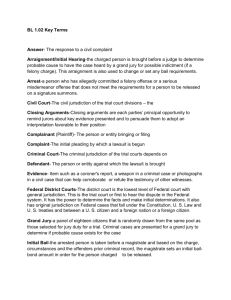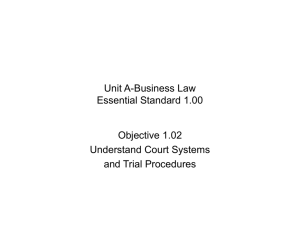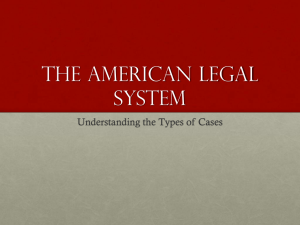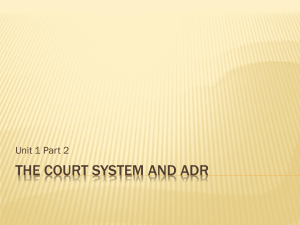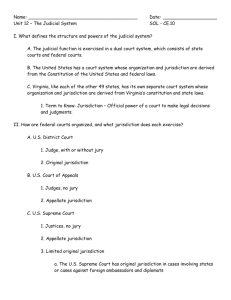1.02 Notes
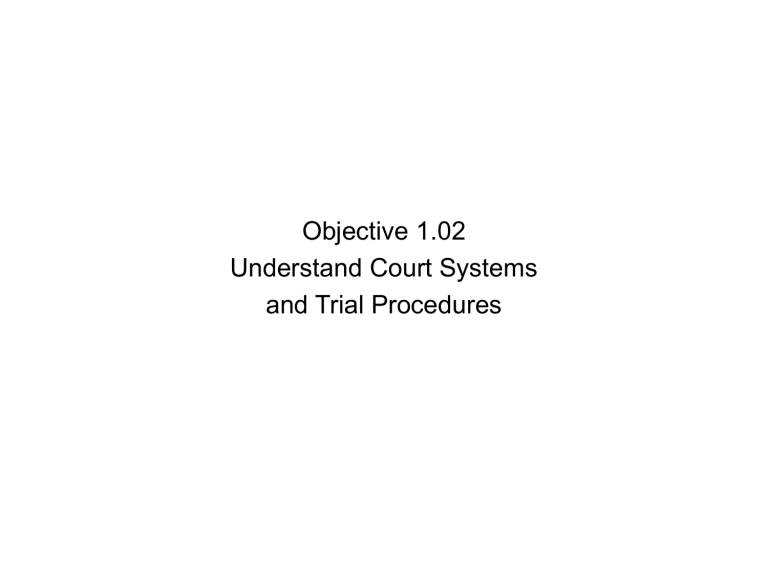
Objective 1.02
Understand Court Systems and Trial Procedures
Federal Courts
U. S. Supreme Court
• Highest court in land
• Both original and appellate jurisdiction
• Exercises its appellate jurisdiction over cases from lower courts
U. S. Court of Appeals
• Appellate jurisdiction over the district courts, certain specialized federal courts and many
Federal agencies.
• Do not accept any new evidence or call witnesses.
• Review the trial transcripts, legal briefs and oral arguments from attorneys.
• 13 Federal Courts of Appeal - 12 of these are Circuit Courts and each is assigned a geographic area of the U. S.
• Thirteenth court is assigned to the federal circuit
– Handles appealed patent cases from district court
– Handles appeals from courts with special jurisdictions.
U. S. District Courts
• Lowest level of Federal court with general jurisdiction
• First to hear the dispute in the Federal system
• Power to determine the facts and make initial determinations
• Original jurisdiction on Federal cases that fall under the Constitution, U. S. Law and
U.S. treaties and between a U. S. citizen and a foreign nation or a foreign citizen.
N. C. State Courts
N. C. Supreme Court
• State’s highest court
• Chief Justice and six associate justices
• Decide cases appealed from lower courts, including from the Court of
Appeals.
• No jury
• Makes no determinations of fact
• Considers only questions of law
• Means resolving a party’s claim that there were errors in legal procedures or in judicial interpretation of the law in the trial court or the Court of Appeals.
N. C. Court of Appeals
• Intermediate appellate court
• Fifteen judges
– Sit in panels of three to hear cases with one Chief Judge of the Court of Appeals appointed by the
Chief Justice of the Supreme Court
• Decides only questions of law
N. C. State Courts (continued)
N. C. Superior Court
• Trial court divisions
• To determine the facts of cases
• General jurisdiction.
N. C. District Court
• Hold trials to determine the facts of cases
Magistrates’ Court
– Both civil and criminal matters
– Preside over “small claims "court
– Conduct certain preliminary proceedings and are authorized to dispose of some criminal cases by pleas of guilty or by trial.
N. C. State Courts (continued)
Civil Court
– Civil jurisdiction of the trial court divisions – the superior court and district court is concurrent
Criminal Court
– Criminal jurisdiction
– Depends on the type of offense charged
– With a few exceptions, the superior court has exclusive jurisdiction over all felonies.
Juvenile Court
– Exclusive, original jurisdiction over all juvenile cases
– Children under the age of sixteen who are accused of being “delinquent” and children under the age of eighteen who are “undisciplined”, “abused”,
“neglected” or “dependent.”
– All records of juvenile proceedings are confidential and not open to the public.
Trial Procedures
Criminal Cases
Arrest
• Person who has allegedly committed a felony offense or a serious misdemeanor offense that does not meet the requirements for a person to be released on a signature summons.
Initial Bail
• The arrested person is taken before a magistrate and based on the charge, circumstances and the offenders prior criminal record, the magistrate sets an initial bail-bond amount in order for the person charged to be released.
Arraignment/Initial Hearing
• The charged person is brought before a judge to determine probable cause to have the case heard by a grand jury for possible indictment (if a felony charge).
• This arraignment is also used to change or set any bail requirements.
Trial Procedures
Criminal Cases
Grand Jury
• Panel of eighteen citizens
• Randomly drawn from the same pool as those selected for jury duty for a trial
• Determine if probable cause exists for the case to go to trial
Civil Cases
Complainant (Plaintiff)
• Person or entity bringing or filing the lawsuit.
Defendant
• Person or entity against which the lawsuit is brought
Complaint
• I nitial pleading by which a lawsuit is begun
Answer
• Response to a civil complaint
Summons
• Issued by the Clerk of Court
• Official notice of the lawsuit
Pleadings
• Papers requesting something or responding to a request that are filed in the case, including the complaint and answer
Trial Procedures
Steps to a Trial
(Criminal and Civil)
Jury Selection
• Attorneys for both prosecution (plaintiff if civil) are allowed to strike a specific number of jurors without justification referred to as Voir dire
Opening Statement
• Beginning of the trial
• Limited to outlining facts
• Set the basic scene for the jurors
• Introduce them to the core dispute(s) in the case
• Provide a general road map of how the trial is expected to unfold
Steps to a Trial
(Criminal and Civil)
Testimony
• Declaration by a witness under oath, as that given before a court or deliberative body
Evidence Presentation
• Item such as a coroner's report, a weapon in a criminal case or photographs in a civil case that can help corroborate or refute the testimony of other witnesses
Closing Arguments
• Opportunity to remind jurors about key evidence presented and to persuade them to adopt an interpretation favorable to each sides position
Jury Instructions
• Given by the trial judge
• Specifically state what the defendant can be found guilty of and what the prosecution or plaintiff has to prove in order for a guilty verdict.
Steps to a Trial
(Criminal and Civil)
Jury Deliberation
• jury is charged to find the defendant guilty or not guilty
• in criminal case by all 12 members
• in civil case by the majority of the jurors in a civil trial
Verdict/Sentence
• in a criminal trial the jury must make a decision beyond a reasonable doubt
• in a civil trial the jury must make a decision by a preponderance of the evidence.
• in a civil case the verdict is sometimes called a judgment.

